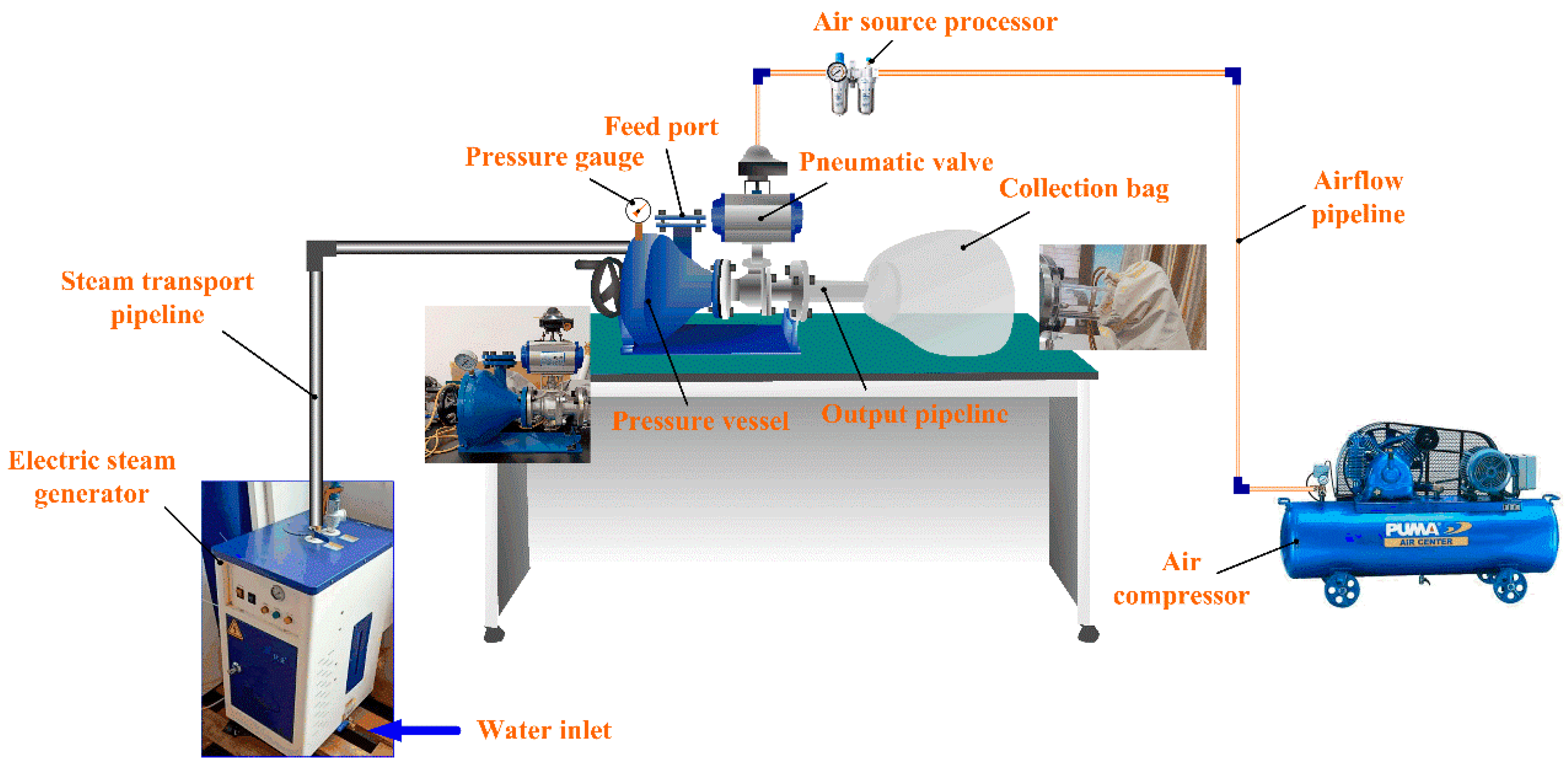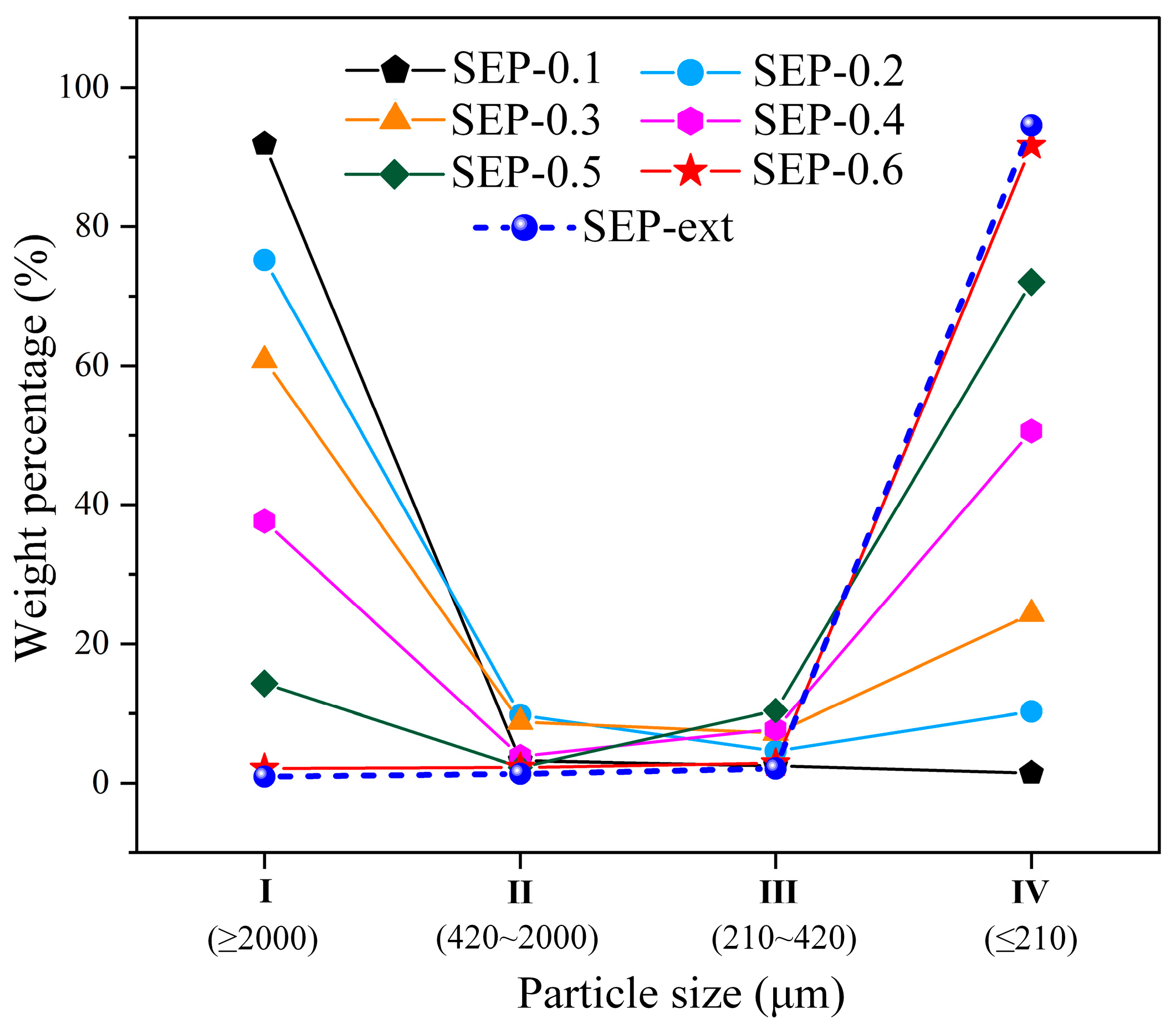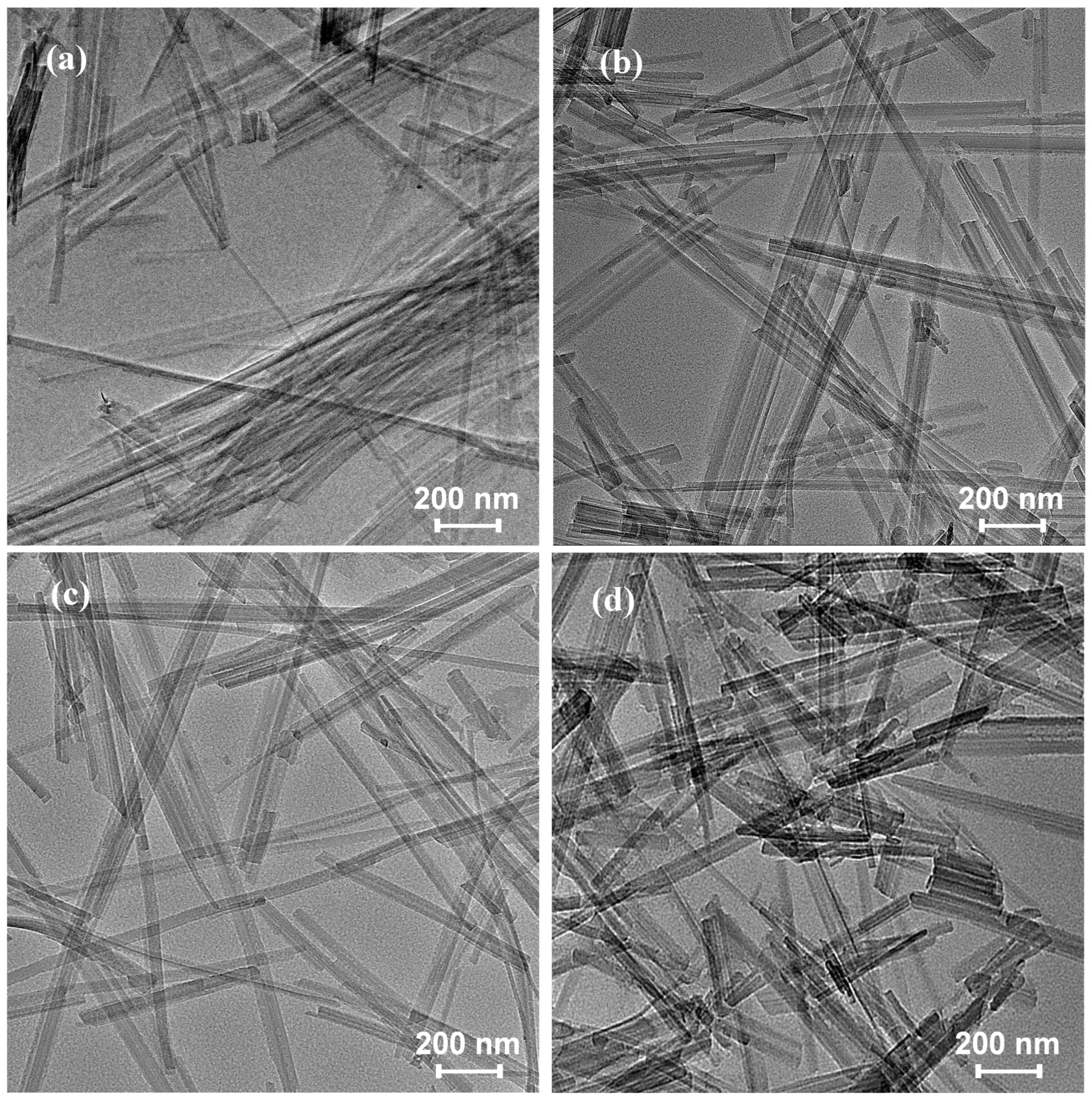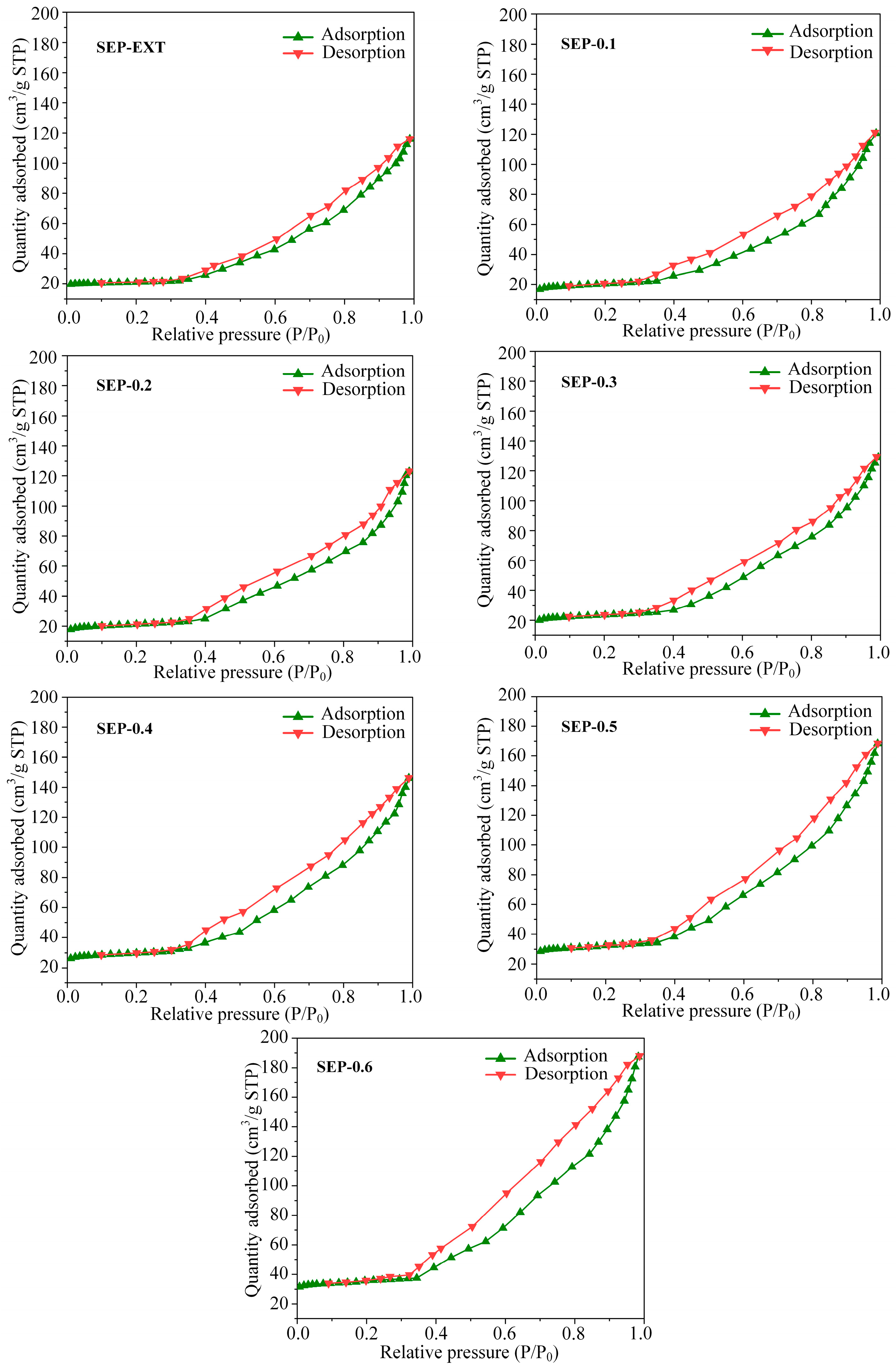A Novel Approach for Preparing Sepiolite Micron Powder Based on Steam Pressure Changes
Abstract
:1. Introduction
2. Materials and Methods
2.1. Material
2.2. Experimental Method
2.3. Characterization
3. Results and Discussion
3.1. Particle Size Distribution
3.2. Morphological Characterization
3.3. XRD Analysis
3.4. Microstructure Analysis
4. Conclusions
- Sepiolite powders with a mass ratio of more than 90% and a particle size of less than 22 μm can be successfully obtained at the steam pressure of 0.6 MPa.
- The steam pressure change method has obvious advantages over mechanical extrusion in preserving fiber integrity.
- Compared to the sepiolite after extrusion, the specific surface area and micropore volume of the sepiolite subjected to steam pressure changes were increased by 59.6% and 216.7%, respectively. This indicates that the steam pressure change method could be described as a method for activating the surface of sepiolite. The sepiolite micron powders prepared using this method have a certain potential for applications as adsorbents.
Author Contributions
Funding
Institutional Review Board Statement
Informed Consent Statement
Data Availability Statement
Conflicts of Interest
References
- Rytwo, G.; Tropp, D.; Serban, C. Adsorption of diquat, paraquat and methyl green on sepiolite: Experimental results and model calculations. Appl. Clay Sci. 2002, 20, 273–282. [Google Scholar] [CrossRef]
- Suarez, M.; Garcia-Rivas, J.; Garcia-Romero, E.; Jara, N. Mineralogical characterisation and surface properties of sepiolite from Polatli (Turkey). Appl. Clay Sci. 2016, 131, 124–130. [Google Scholar] [CrossRef]
- Zhuang, G.; Gao, J.; Chen, H.; Zhang, Z. A new one-step method for physical purification and organic modification of sepiolite. Appl. Clay Sci. 2018, 153, 1–8. [Google Scholar] [CrossRef]
- Hu, Y.; Xu, T.; Xu, H.; Zhong, Y.; Zhang, L.; Wang, B.; Sui, X.; Feng, X.; Mao, Z. Preparation and properties of sepiolite-based 3d flame-retardant aerogel. Clay Clay Miner. 2022, 70, 865–881. [Google Scholar] [CrossRef]
- Yin, W.; Liu, M.; Chen, Y.; Yao, Q.; Fu, S.; Zhou, G. Microwave-assisted preparation of Mn3O4@sepiolite nanocomposite for highly efficient removal of uranium. Appl. Clay Sci. 2022, 228, 106597. [Google Scholar] [CrossRef]
- Ruiz, A.I.; Ruiz-García, C.; Ruiz-Hitzky, E. From old to new inorganic materials for advanced applications: The paradigmatic example of the sepiolite clay mineral. Appl. Clay Sci. 2023, 235, 106874. [Google Scholar] [CrossRef]
- Wang, Y.; Lin, X.; Wang, L.; Yang, Y.; Zhang, Y.; Pan, A. Tailoring the crystal-chemical states of water molecules in sepiolite for superior coating layers of Zn metal anodes. Adv. Funct. Mater. 2023, 33, 2211088. [Google Scholar] [CrossRef]
- Qiu, P.; Guo, L.; Qi, Y.; Cheng, M.; Jing, Z. Hydrothermal solidification of sepiolite into a cemented sepiolite aggregate for humidity regulation and formaldehyde removal. Clay Miner. 2020, 55, 320–328. [Google Scholar] [CrossRef]
- Tezer, M.M.; Bundur, Z.B. Use of natural minerals to immobilize bacterial cells for remediating cracks in cement-based materials. J. Mater. Civil. Eng. 2022, 34, 04021461. [Google Scholar] [CrossRef]
- Li, X.; Ran, M. Gypsum-Based humidity-control material: Preparation, performance and its impact on building energy consumption. Materials 2023, 16, 5211. [Google Scholar] [CrossRef]
- Castro-Smirnov, F.A.; Piétrement, O.; Aranda, P.; Cam, E.L.; Ruiz-Hitzky, E.; Lopez, B.S. Biotechnological applications of the sepiolite interactions with bacteria: Bacterial transformation and DNA extraction. Appl. Clay Sci. 2020, 191, 105613. [Google Scholar] [CrossRef]
- Lisuzzo, L.; Wicklein, B.; Dico, G.L.; Lazzara, G.; Real, G.D.; Aranda, P.; Ruiz-Hitzky, E. Functional biohybrid materials based on halloysite, sepiolite and cellulose nanofibers for health applications. Dalton Trans. 2020, 49, 3830. [Google Scholar] [CrossRef]
- Ain, N.U.; Masood, F.; Noor, M.; Farooq, M. Fabrication and evaluation of antibacterial properties of Cu2O/sepiolite-PVA nanocomposite hydrogels against multidrug-resistant bacteria. Appl. Clay Sci. 2022, 229, 106663. [Google Scholar] [CrossRef]
- Biddeci, G.; Spinelli, G.; Colomba, P.; Di, B.F. Halloysite nanotubes and sepiolite for health applications. Int. J. Mol. Sci. 2023, 24, 4801. [Google Scholar] [CrossRef]
- Cornejo, J.; Hermosin, M.C. Structural alteration of sepiolite by dry grinding. Clay Miner. 1988, 23, 391–398. [Google Scholar] [CrossRef]
- Xu, J.; Zhang, J.; Wang, Q.; Wang, A. Disaggregation of palygorskite crystal bundles via high-pressure homogenization. Appl. Clay Sci. 2011, 54, 118–123. [Google Scholar] [CrossRef]
- Wang, F.; Liang, J.; Tang, Q.; Meng, J.; Wu, Z.; Li, G. Microstructure of sepiolite and its adsorbing properties to dodecanol. T. Nonferr. Metal. Soc. 2006, 16, 406–410. [Google Scholar] [CrossRef]
- Krekeler, M.; Guggenheim, S. Defects in microstructure in palygorskite–sepiolite minerals: A transmission electron microscopy (TEM) study. Appl. Clay Sci. 2008, 39, 98–105. [Google Scholar] [CrossRef]
- Wang, W.; Dong, W.; Tian, G.; Sun, L.; Wang, Q.; Hui, A.; Mu, B.; Wang, A. Highly efficient self-template synthesis of porous silica nanorods from natural palygorskite. Powder Technol. 2019, 354, 1–10. [Google Scholar] [CrossRef]
- Mao, Y.; Xia, W.; Peng, Y.; Xie, G. Relationship model between pore wetting and floatability of active carbon: Potential guidance on porous mineral flotation. Miner. Eng. 2020, 157, 106556. [Google Scholar] [CrossRef]
- Ruiz-Hitzky, E. Molecular access to intracrystalline tunnels of sepiolite. J. Mater. Chem. 2001, 11, 86–91. [Google Scholar] [CrossRef]
- Suárez, M.; García-Romero, E. Variability of the surface properties of sepiolite. Appl. Clay Sci. 2012, 67–68, 72–82. [Google Scholar] [CrossRef]
- Can, M.F.; Çınar, M.; Benli, B.; Özdemir, O.; Çelik, M.S. Determining the fiber size of nano structured sepiolite using Atomic Force Microscopy (AFM). Appl. Clay Sci. 2010, 47, 217–222. [Google Scholar] [CrossRef]
- Bialczyk, J.; Natkański, P.; Kuśtrowski, P.; Czaja-Prokop, U.; Bober, B. Removal of cyanobacterial anatoxin-a from water by natural clay adsorbents. Appl. Clay Sci. 2017, 148, 17–24. [Google Scholar] [CrossRef]
- Chen, J.; Jin, Y.; Qian, Y.; Hu, T. A new approach to efficiently disperse aggregated palygorskite into single crystals via adding freeze process into traditional extrusion treatment. IEEE Trans. Nanotechnol. 2010, 9, 6–10. [Google Scholar] [CrossRef]
- Xu, J.; Wang, W.; Wang, A. A novel approach for dispersion palygorskite aggregates into nanorods via adding freezing process into extrusion and homogenization treatment. Powder Technol. 2013, 249, 157–162. [Google Scholar] [CrossRef]
- Milsch, H.; Kristinsdottir, L.H.; Spangenberg, E.; Bruhn, D.; Flóvenz, Ó.G. Effect of the water-steam phase transition on the electrical conductivity of porous rocks. Geothermics 2010, 39, 106–114. [Google Scholar] [CrossRef]
- Torro-Palau, A.; Fernandez-Garcia, J.C.; Orgiles-Barcelo, C.; Pastor-Bias, M.M.; Martin-Martinez, J.M. Stuctural modification of sepiolite (natural magnesium silicate) by thermal treatment: Effect on the properties of polyurethane adhesives. Int. J. Adhes. Adhes. 1997, 17, 111–119. [Google Scholar] [CrossRef]
- Echt, T.; Plank, J. An improved test protocol for high temperature carrying capacity of drilling fluids exemplified on a sepiolite mud. J. Nat. Gas. Sci. Eng. 2019, 70, 102964. [Google Scholar] [CrossRef]
- Orlova, Y.; Linker, R.; Spektor, B. Expansion of cracks in chicken eggs exposed to sub-atmospheric pressure. Biosyst. Eng. 2012, 112, 278–284. [Google Scholar] [CrossRef]
- Chen, Y.; Zuo, J.P.; Li, Z.H.; Dou, R. Experimental investigation on the crack propagation behaviors of sandstone under different loading and unloading conditions. Int. J. Rock Mech. Min. 2020, 130, 104310. [Google Scholar] [CrossRef]
- Zhou, F.; Yan, C.; Zhang, Y.; Tan, J.; Wang, H.; Zhou, S.; Pu, S. Purification and defibering of a Chinese sepiolite. Appl. Clay Sci. 2016, 124–125, 119–126. [Google Scholar] [CrossRef]
- Yaniv, O.; Segula, M.; Robert, R.A.; Giora, R. Immobilization of Rhus vernicifera laccase on sepiolite; effect of chitosan and copper modification on laccase adsorption and activity. Appl. Clay Sci. 2018, 152, 143–147. [Google Scholar] [CrossRef]
- Wu, Q.F.; Carison, K.; Cheng, Q.; Wang, X.S.; Li, Z.H. Interactions between Cationic Dye Toluidine Blue and Fibrous Clay Minerals. Crystals 2021, 11, 708. [Google Scholar] [CrossRef]









| Constituent | Weight % |
|---|---|
| SiO2 | 52.79 |
| MgO | 17.32 |
| Al2O3 | 3.21 |
| CaO | 3.37 |
| Fe2O3 | 0.75 |
| Na2O | 0.08 |
| K2O | 0.91 |
| TiO2 | 0.25 |
| Loss on ignition (LOI) | 21.32 |
| Sample | Pressure (MPa) | Temperature (°C) |
|---|---|---|
| SEP-0.1 | 0.1 | 99.09 |
| SEP-0.2 | 0.2 | 119.62 |
| SEP-0.3 | 0.3 | 132.68 |
| SEP-0.4 | 0.4 | 142.92 |
| SEP-0.5 | 0.5 | 151.11 |
| SEP-0.6 | 0.6 | 158.08 |
| Sample | SBET (m2 g−1) | Smicro (m2 g−1) | Vmicro (cm3 g−1) | Vtotal (cm3 g−1) |
|---|---|---|---|---|
| SEP-ext | 88.73 | 16.76 | 0.0048 | 0.1841 |
| SEP-0.1 | 80.15 | 15.81 | 0.0047 | 0.1773 |
| SEP-0.2 | 84.96 | 17.51 | 0.0049 | 0.1963 |
| SEP-0.3 | 93.25 | 32.58 | 0.0069 | 0.2438 |
| SEP-0.4 | 111.76 | 61.13 | 0.0115 | 0.2520 |
| SEP-0.5 | 124.05 | 80.39 | 0.0120 | 0.2573 |
| SEP-0.6 | 141.63 | 97.66 | 0.0152 | 0.2681 |
Disclaimer/Publisher’s Note: The statements, opinions and data contained in all publications are solely those of the individual author(s) and contributor(s) and not of MDPI and/or the editor(s). MDPI and/or the editor(s) disclaim responsibility for any injury to people or property resulting from any ideas, methods, instructions or products referred to in the content. |
© 2024 by the authors. Licensee MDPI, Basel, Switzerland. This article is an open access article distributed under the terms and conditions of the Creative Commons Attribution (CC BY) license (https://creativecommons.org/licenses/by/4.0/).
Share and Cite
Yang, W.; Zhou, Y.; Song, J.; Li, Y.; Gong, T. A Novel Approach for Preparing Sepiolite Micron Powder Based on Steam Pressure Changes. Materials 2024, 17, 3574. https://doi.org/10.3390/ma17143574
Yang W, Zhou Y, Song J, Li Y, Gong T. A Novel Approach for Preparing Sepiolite Micron Powder Based on Steam Pressure Changes. Materials. 2024; 17(14):3574. https://doi.org/10.3390/ma17143574
Chicago/Turabian StyleYang, Wenjia, Youhang Zhou, Jialin Song, Yuze Li, and Tianyu Gong. 2024. "A Novel Approach for Preparing Sepiolite Micron Powder Based on Steam Pressure Changes" Materials 17, no. 14: 3574. https://doi.org/10.3390/ma17143574





